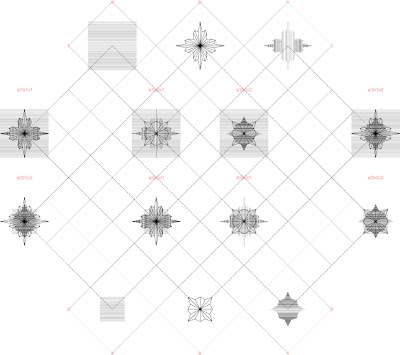1. Work with line.
2. Work with 10x10 unit.
3. Build up line to suggest depth.
4. Build up line to suggest curves.
5. Work solely with straight lines.
6. Work with line quantities in multiples of 40.
7. Use a geometric series based on 2 to create the basis for density gradients.
8. Locate all elements on center to one another.
9. Lay out grid based on 10x10 module.
10. All elements to be either parallel or normal to one another. No tangents.
11. All elements, combinations, and notation to be located on center at vertices within the grid.
12. Locate all notation within the grid.
13. No scaling; all 2 components to be smaller than 1 components but with internal lines still proportional to whole.
14. Only one turn is allowed in each path from component to combination.
Decisions that needed to have been incorporated:
1. Use line quantities in multiples of 50.
2. Determine notation size based on 10x10 unit.
3. Determine ratio of 2 components to 1 components (1:2?).
4. Use rational organization between 1s and 2s; same relationship between A-A', B-B', C-C'.
5. Create congruent logic on the placement of all notations.
6. Refine the grid to another 1 or 2 degrees.
7. Use grid to build depth within the drawing.
8. Make each path from component to combination unique.
9. Create opaque field around each component/combination so that lines do not reach actual centers. (Or, not?)
The result:
25 October 2010
after_thought as common noun: Galatea is her name
Oh, after_thought. You and I struggled, and I don't think either of us won; but the good thing is, neither of us lost, either.
Here's what happened.
What started as an innocent exercise in lasercutting got entirely out of hand.
I started with two small (4"x8") sheets of basswood and cut small rhomboids out of them. No particular pattern; just a smattering of tiny diamonds. I was instantly fascinated by how the extensive but small-seeming removal made the basswood behave differently; it became more flexible, acting more like fabric or paper than wood.
In further testing different patterns and densities, I discovered that layering them produced hypnotic effects. It became a compelling activity simply to sit and move them back and forth in front of one another. Two identical diamond fields began to produce new patterns; they reshaped the world behind them; I had know know more.
Further tests into material (limited, due to machinic constraints, to acrylic and chipboard) yielded the knowledge that patterns got lost in the clear material, even when sanded or painted; the chipboard, however, was a gold mine. I dropped the basswood and did my best to go all the way with chipboard: back to the densities, over a dozen colors, trying to find a logic behind the sizes of the apertures. I dropped the rhomboid (though it would have been nice to keep it) and moved to a circle; it was the cleanest script I could find for raster images, and since I have not yet learned to script myself, it was an acceptable substitute.
Words do not describe the ongoing fascination I had in your early stages. Those dots! Those hypnotic, sensual, decadent fields of just-barely-differentiated circles! I'm going back to that, Galatea, and the smaller scale that made them so captivating. Come with me, my lovely. Show me how to draw you out.
Subscribe to:
Comments (Atom)


